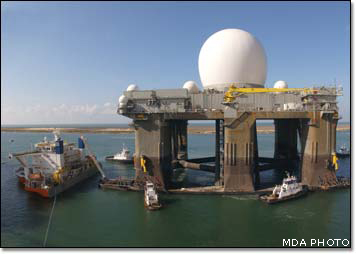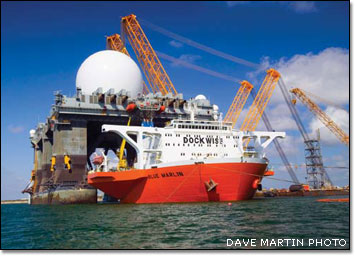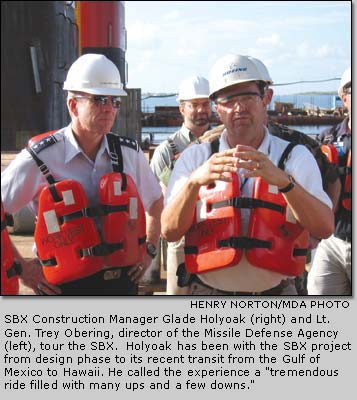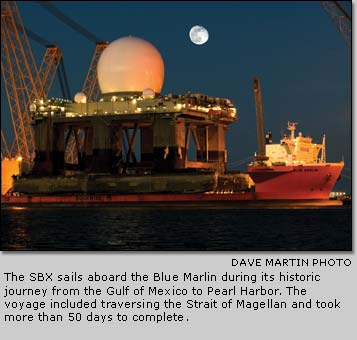| 
Bon voyage, indeed
SBX makes a stop in Hawaii en route to
Alaska
BY LYNN FARROW

 If
they hurry, visitors to Pearl Harbor, Hawaii, can observe a marvel of
modern technology—the Sea-Based X-Band Radar—while it is temporarily
moored in the famous harbor undergoing refurbishment and a much-needed
paint job. If
they hurry, visitors to Pearl Harbor, Hawaii, can observe a marvel of
modern technology—the Sea-Based X-Band Radar—while it is temporarily
moored in the famous harbor undergoing refurbishment and a much-needed
paint job.
Late last year, the 50,000-ton SBX, a modified oil-drilling vessel, made
its way from Corpus Christi, Texas, around South America, and through
the South Pacific Ocean to Hawaii. A component of the U.S. Missile Defense
Agency's Ground-Based Midcourse Defense program, the SBX provides tracking,
discrimination and hit-assessment functions. Its radar is so sensitive
that "if a baseball were launched on the West Coast, it could be
detected on the East Coast by this radar," said Pam Rogers, spokeswoman
for the Missile Defense Agency in Huntsville, Ala.
As prime contractor for the GMD program, Boeing is responsible for the
development and integration of the GMD system components, including the
SBX.
 To
save time and reduce wear and tear on the radar system, the SBX—which
stands 28 stories above the ocean—was loaded onto a heavy transport
vessel, the Motor Vessel Blue Marlin (top and above)
in November 2005 to make the 16,000-mile journey. "Using
the Blue Marlin made the most sense for our program and for our
customer," said Pat Shanahan, Boeing Missile Defense vice president
and general manager. "We saved a considerable amount of time and
resources. The transit time required by the Blue Marlin was less
than half what the SBX would require under its own power." The loading
process to position the SBX on board the Blue Marlin and making
the vessel ready for the voyage took several days. The Blue Marlin—owned
and operated by Dockwise Shipping B.V. of Breda, The Netherlands, and
under the command of Captain Jurijs Ivanovs (below)—is the world's
largest heavy-transport vessel. To
save time and reduce wear and tear on the radar system, the SBX—which
stands 28 stories above the ocean—was loaded onto a heavy transport
vessel, the Motor Vessel Blue Marlin (top and above)
in November 2005 to make the 16,000-mile journey. "Using
the Blue Marlin made the most sense for our program and for our
customer," said Pat Shanahan, Boeing Missile Defense vice president
and general manager. "We saved a considerable amount of time and
resources. The transit time required by the Blue Marlin was less
than half what the SBX would require under its own power." The loading
process to position the SBX on board the Blue Marlin and making
the vessel ready for the voyage took several days. The Blue Marlin—owned
and operated by Dockwise Shipping B.V. of Breda, The Netherlands, and
under the command of Captain Jurijs Ivanovs (below)—is the world's
largest heavy-transport vessel.
 Too
big for the Panama Canal, the radar platform was routed south through
the Strait of Magellan, arriving in Hawaii in January for refurbishment. Too
big for the Panama Canal, the radar platform was routed south through
the Strait of Magellan, arriving in Hawaii in January for refurbishment.
The SBX will head for its home port of Adak, Alaska, under its own power
later this year. From Adak, the radar platform will move throughout the
Pacific Ocean in support of advanced missile-defense testing and defensive
operations. Over time, the SBX will help protect the United States, its
deployed forces, allies and friends from potential missile attacks.
lynn.farrow@boeing.com
| On the
fast track Glade Holyoak was the SBX construction manager
for Boeing. Here, in his own words, he describes building the SBX
system from the customer's request for proposal to the successful
voyage to Pearl Harbor, Hawaii:
 Five
years ago a group was assembled to provide a professional opinion
on the viability of deploying a large, sea-based radar that would
be mounted on a floating platform. In September 2005, the SBX system,
including personnel and equipment, successfully tracked satellites
while operating in the Gulf of Mexico. To be a part of this "first-in-the-world"
project has been a tremendous ride filled with many ups and a few
downs. Five
years ago a group was assembled to provide a professional opinion
on the viability of deploying a large, sea-based radar that would
be mounted on a floating platform. In September 2005, the SBX system,
including personnel and equipment, successfully tracked satellites
while operating in the Gulf of Mexico. To be a part of this "first-in-the-world"
project has been a tremendous ride filled with many ups and a few
downs.
I joined the project in November 2002 during the design phase and
was instructed that this project was on a fast track and would be
successful. The prime designer for modifications to the oilfield
platform was The Glosten Associates of Seattle. Several Gulf of
Mexico shipyards were requested to provide conversion proposals
based on a 30 percent design package with the successful bidder
to participate in final design. Keppel AmFELS of Brownsville, Texas,
was the successful prime bidder.
The first piece of steel for the conversion was cut on Sept. 25,
2003. After addition of about 5,000 tons of steel, all of the propulsion
systems, living quarters, payload support infrastructure, and control
equipment—and after completion of systems startup and operational
testing—the SBX-1 departed Brownsville on builder's trials
on March 13, 2005.
 After
successful sea trials, the ship arrived at Kiewit Offshore Services
in Ingleside, Texas, to integrate the radar with the vessel and
install the radar dome. Other work, including installation of new
seawater service pumps and mooring winches, also was accomplished. After
successful sea trials, the ship arrived at Kiewit Offshore Services
in Ingleside, Texas, to integrate the radar with the vessel and
install the radar dome. Other work, including installation of new
seawater service pumps and mooring winches, also was accomplished.
SBX-1 completed two additional sea trials in the Gulf of Mexico.
The final sea trial culminated in achieving American Bureau of Shipping
Class Certification—required for unrestricted operations of
the ship in all open oceans—and in demonstrating the system
was capable of tracking satellites.
The next great adventure included loading the SBX onto a heavy-lift
vessel, the M.V. Blue Marlin, for transit from the Gulf
of Mexico to Hawaii. The professionalism
with which this complex procedure was carried out was tremendous.
The success of a fast-track project depends on the expertise of
the people involved. In my 30 years of management, I can sincerely
say this project had the best of the best. It has been a real pleasure
being associated with this team throughout the project. |
|

